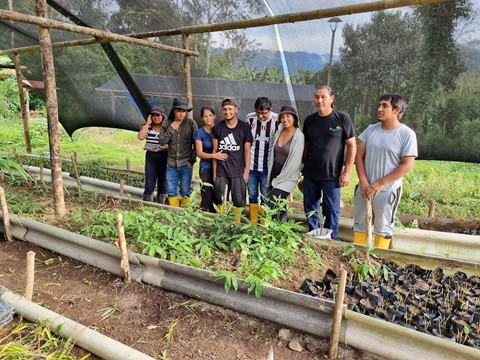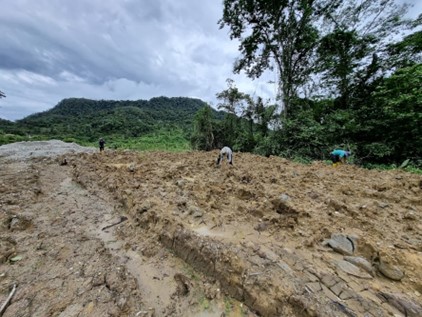Deforestation and health hazards are among the impacts associated with artisanal and small-scale gold mining. Using native bamboos to accelerate post-mining land recovery could be a successful strategy, as Lucy Binfield (University of British Columbia) and Margaret Stern (EcoDecision) describe.
Bamboo plants usually bring to mind images of the giant panda munching on their culms and leaves on the hilltops of Asia, but native bamboos also occur naturally over vast expanses of the Amazon rainforest. Using our combined experience working with bamboo for livelihood development and the provision of ecosystem services, we are exploring the use of native bamboos to catalyse the environmental recovery of degraded gold mining lands in the Amazon. Here, we discuss the challenges and opportunities of our approach.
Mining in the Amazon is rampant and seems unstoppable
Global supply chains of gold, including jewellery and electronics components, may trace their product back to small-scale gold mining in the Amazon basin. Persistently high gold prices on world markets (US$ 62,000/kilo on 24 Jan 2023) and growing demand for the precious metal have driven a huge expansion in Amazonian mining since the early 2000s. Alongside providing economic benefits, gold mining brings environmental and social problems that arise from unethical labour practices, unfettered deforestation of mining sites, alterations of fluvial processes, and the use of mercury in the gold extraction process. Although mercury use in the mining process is illegal in many Amazonian countries, it is a major contributor to human health problems and ecosystem impacts; traces of this heavy metal have been found in most abandoned mine sites and much of the fish traditionally consumed by local communities.
The negative environmental impacts associated with gold mining are felt long after operations have ceased: deforested land and pit lakes, dug by mechanical excavators and left behind after abandonment of mining operations, represent some of the most severely degraded landscapes in the region. At many sites, land has been stripped of topsoil, the nutrient-rich top part of the soil that is essential for plant growth. The deep water-filled pools left behind by heavy machinery provide an ideal breeding ground for mosquitos, bringing elevated transmission rates of malaria, dengue fever, and other mosquito-borne illnesses to nearby communities and urban centres.
Mitigating the devastating effects of mining by returning greenery and biodiversity to severely degraded lands is clearly needed, but the remote nature of mining in the Amazon makes legal enforcement of regulations close to impossible. Furthermore, most small-scale miners in the Amazon operate illegally on the state’s or someone else’s land and have no incentive to close mine sites appropriately or carry out environmental recovery activities. Once the gold has been extracted, transient miners move on to another site, or leave the area with their earnings. Notable exceptions exist, however, particularly where indigenous or mestizo landowners have been mining riverside sites on their own land and recognize their lack of future economic options (e.g., agroforestry, tourism) on degraded mine sites; they may seek ways to recover the landscape, but lack the know-how.

A strategy for scaling-up land recovery
Experimental methods for land recovery of Amazon mining sites have usually involved planting native tree species with commercial or subsistence value. These involve numerous time and labour intensive steps: collect seeds or seedlings of desired tree species, establish and maintain a nearby nursery, dig holes, set plants, include organic inputs, and then monitor and support the nutrient and water requirements of young sun-tolerant trees over several years until soil improvements facilitate the return of other native plants and animals. Initial tree planting costs have ranged from USD 1600-3000 per hectare per year, and as a result, most land restoration efforts have been carried out as a small-scale projects.
Due to the enormous scale of this challenge, there is a serious need to test and prove alternative strategies for land recovery. We believe that the key to reducing time and costs is to work with native Amazonian bamboos – fast-growing, rapidly-colonizing, woody grasses that produce abundant leaf litter – to improve soil conditions so that natural ecological processes take over sooner rather than later. Towards that end, we are field-testing the use of Guadua bamboos to jump-start landscape recovery in the Ecuadorian Amazon. upfront nursery costs are similar to tree species, but the unique combination of physical, ecological, and physiological characteristics of bamboos will speed up soil recovery and require less follow-up to create enabling conditions for natural ecological succession.
A growing volume of literature explores the role of different bamboo species in land recovery with promising results at sites around the world, and we are confident that bamboo can play a role in land recovery of Amazonian gold mining sites too. Unlike trees with a single trunk, bamboos are clonal, with many stems comprising a single plant, and grow quickly both vertically and horizontally via their underground stems, known as rhizomes. This allows bamboo plants to repopulate a degraded area much faster than most tree species. As well, bamboos grow on a wide variety of soils, including nutrient-poor soils. The extensive underground part of the bamboo plant binds tightly to soil particles, reducing erosion and loss of precious nutrients into nearby waterways; their falling leaves and stems provide organic material that facilitates the regeneration of topsoil. After a disturbance in the Amazon, such as a blowdown or a fire, bamboos are often the first plants to repopulate the newly opened canopy or charred land, paving the way for trees to grow and the renowned Amazonian biodiversity to return.

Bamboo propagation to overcome plant availability bottleneck
Bamboos may grow fast when planted in the field, but getting hold of enough bamboo plants for land recovery is a challenge. Bamboos primarily propagate vegetatively, not by seed, so to be successful there is a need to produce a lot of clones quickly. In our pilot project in Ecuador, we considered two different ways to create a stock of new bamboo plants, one using vegetative cuttings and rhizome buds from mature bamboos in nature, and the other involving micropropagation through tissue culture in a plant biotechnology lab.
Ecuador has three principal biogeographical regions: the Pacific coastal plain, the Andes mountains, and the Amazon basin. On the coast, Guadua bamboo has been used and cultivated for centuries, so local people recognize its virtues and know how to propagate and grow it. However, in the Amazon, where valuable timber species abound, few people recognize bamboos, and even fewer know how to grow them. Our team has been sharing knowledge about bamboo silviculture, and learning about the kinds of degraded sites Amazonian bamboos will do best on. Most existing research on using bamboos to regenerate degraded mine lands come from case studies in other parts of the world with different bamboo species and habitats, so we have installed demonstration plots at different degraded sites to determine appropriate parameters for successful recovery in the local context.
We hope that native bamboos will become protagonists for landscape recovery in the Amazon as organizations and motivated mining companies search for faster and more cost-effective ways to recover abandoned land, and as we improve knowledge and results of this innovative process. Obviously, using bamboos to accelerate recovery will not solve all the complex issues facing the Amazon’s degraded mining lands. Policy changes, law enforcement, strengthened funding pathways, and community education all have a role to play. But pushing down the price and speeding up the natural ecological process by taking advantage of the unique growth characteristics of native bamboos, could be the keys to a successful gold mining land recovery strategy in the Amazon basin.
Notes:
• The views expressed here are of the author rather than the Centre or the LSE
• Please read our Comments Policy before commenting
• Binfield and Stern were both elected 2021-2022 World Bamboo Foundation Global Fellows and are very appreciative of WBF’s support to coordinate interdisciplinary bamboo research.
• The idea described here forms the basis for a study supported by the Gordon and Betty Moore Foundation, Microsoft, ESRI, and the United States Agency for International Development (USAID).
• The contents are the responsibility of the authors and do not necessarily reflect the views or positions of USAID or the US Government.
• Banner image: Locals panning for gold with wood, in the Napo River, Ecuadorian Amazon / Ksenia Ragozina (Shutterstock)






The potential of native bamboos to restore degraded gold mine sites in the Amazon is truly promising. This study highlights a sustainable approach that could contribute significantly to the region’s ecological recovery.